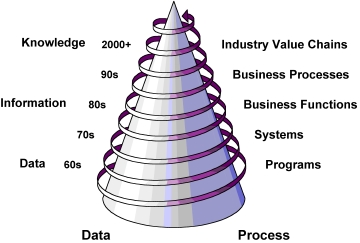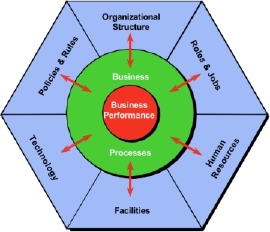Effective Business Transformation through Process Management
The Case for a Business Process Perspective
The history of business management and information systems is full of discussions and debates on the optimal ways to understand the present, analyze directions, and plan for the future. Because of this, I have decided to provide a broad review of and introduction to the topic.
From an Information Management point of view the pendulum has frequently swung between process and data extremes. At the beginning, the predominant approach was 'process' oriented. It seemed that better and more natural computer languages would solve the problem. Over time the 'apparent' secret swung over to focus on databases.
Not far behind these advances, Structured Analysis techniques arose above technical languages. Then Data Modeling techniques came forward to accelerate the move to flexible DBMS.
Techniques for managing information as a corporate resource were introduced next. They added a perspective at one higher level of abstraction than before: that of a functional business area in the corporation. However, fragmentation of business process still existed and the cross-functional integration that businesses required was not yet addressed.
What is happening now is next higher level of abstraction -- that is, the perspective of the integrated business: cross-functional, cross-organizational business processes optimized to deliver top performance for our stakeholders. Its process approach links the strategic and tactical worlds of both business and technology as well as other professional areas of the business. It provides complete traceability from top to bottom and allows whole processes and value chains to be managed as corporate assets.
Business Process Management (BPM)
is the discipline that improves measurable business performance for stakeholders through ongoing synchronization and optimization of capabilities for
enterprise-wide processes.
Tracing from Business to Processes to People
The purpose of any business entity is to contribute to business value either across an enterprise or an industry value chain. The business' performance is measured in terms of key performance indicators (KPIs) and targets and evaluated against the requirements of the business stakeholders.
The business applies a number of reusable resources to enable this transformation. These include:
- the cross-functional processes of the business (despite the fact that they may
not be apparent nor understood),
- the physical facilities, such as offices, factories, equipment, and tools,
- the computing and communications technology to enable information transformation
and flow, knowledge sharing, and human communications,
- the human resources of the organization.
The traditional challenge of any business is to find the balance that optimizes results given strategic performance objectives, scarcity of some of these resources, and the management of business risk.
The Fundamental Role of Business Processes
Business processes transform requirements and consumable resources into business outcomes. Their performance can be measured in exactly the same way as the business overall although the KPIs will be more specific. Consequently, business performance will be directly attributable to process performance and its contribution towards an industry value chain.
Given the general acceptance of the importance of business processes, it makes sense to define the term.
A business process is a repeatable series of activities performed to deliver a product or service to an external stakeholder or value chain. It:
- is initiated by one or more business events and completed only when all of the business outcomes of importance to all stakeholders of the process have been provided.
- transforms inputs of all types into outputs, according to guidance (policies, rules, etc.), employing reusable resources of all types.
- has performance indicators for which measurable objectives can be set and performance evaluated.
- contains logical steps requiring a set of functional capabilities often found in disparate organizational units.
One result of the awakening to the significance of managing our processes cross-functionally is the development of frameworks and techniques to make these cross-functional changes happen.
Managing Concurrent Process Change
The major components of the multiple aspect of concurrent change made possible by Process-based management and renewal are depicted in the hexagon below. Despite the fact that all aspects of change are required and will be considered simultaneously, the business process becomes the baseline and orchestrator of integration delivering:
- improved business performance
- customer satisfaction
- an integrated business solution
- new processes
- new measurement systems
- a managed process environment
- new mechanisms and enablers (including technology)
- new skills
- new HR supports and incentives
- new staff attitudes and behaviors.
A Process Management Framework
To accomplish fundamental renewal, new methods are required. These combine the best of Strategic Planning, Industrial Engineering, Information Engineering, Systems Analysis and Modeling, Organizational Development, and Human Change Management -- all integrated through people-based Project Management. This is no small feat, and it is harder than it appears. Once the senior management of the organization understands and commits to the concepts and challenges of process-based change, a proven comprehensive framework for accomplishing this can take you through the needed phases of renewal which transform the capabilities of the business and leave in place the ability to continue to optimize performance every day.
# # #
About our Contributor:
Online Interactive Training Series
In response to a great many requests, Business Rule Solutions now offers at-a-distance learning options. No travel, no backlogs, no hassles. Same great instructors, but with schedules, content and pricing designed to meet the special needs of busy professionals.














